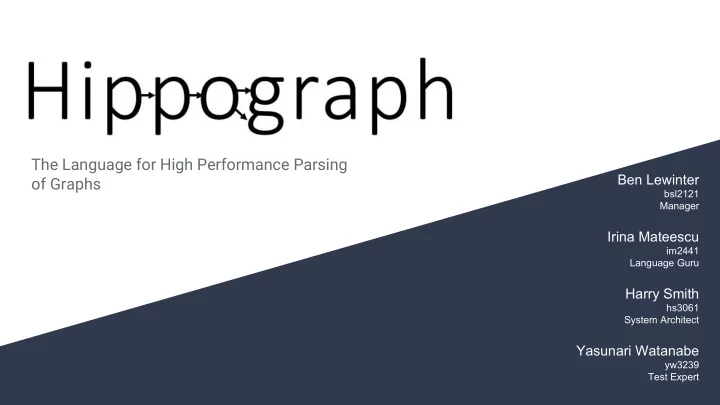

The Language for High Performance Parsing Ben Lewinter of Graphs bsl2121 Manager Irina Mateescu im2441 Language Guru Harry Smith hs3061 System Architect Yasunari Watanabe yw3239 Test Expert
Motivation
A Language for Graphs Graph theory is an important field in computer science, with wide ranging applications We thought there should be a language that made experimenting with and utilizing graphs easier! giraph from Fall 2017 was a major inspiration for us, but we had some ideas for what could be added...
Goals 1. Unified graph type - generic graph type that can handle any type of edge 2. Customizable node names - giving the user greater control over their graphs 3. Cypher-like query capabilities - especially helpful when using graph to store large amounts of data 4. Anonymous functions - for passing in user-defined graph operations 5. Search Strategy Type - specifying traversal method in graph iteration
Workflow and Team Processes
The end result scanner.mll 70 lines Plus parser.mly 160 197 Test Scripts ast.ml 178 sast.ml 109 156 Git Commits semant.ml 446 codegen.ml 823 graph.c 1,152 2 Pies of Pizza hippograph.ml 29
Language Overview
The Basics ● Operators: ○ + - * / ; = . > < => <= == and or not ● Control Flow: ○ While (true) {make_graphs();} ○ For (int i = 0; i <= 10; i = i + 1) ○ If (you_dont_mind()) { do_it(); } else { dont_bother(); } ■ The ELSE clause is optional! ● Primitive Types: ○ int, bool, string ● Comments: ○ (* don’t run me! *)
Function Flavors The Standard: return_type func_name(type1 arg1; type2 arg2; … ) { … } The Condensed: fun<type1:type2: … :typek, ret_typ> f = ret_type (type1 … )( expr )
The Condensed Function ● Allow declarations of functions within the bodies of other functions ○ Stored in variables, which effectively provide the names of anonymous functions ○ Fall in and out of scope with the function! ● Implemented as expressions which resolve to a FUN type ● Passing functions as first class data: WIP.
What about graphs? ● Node Expressions: Node<t1:t2> = expr_of_t1 : expr_of_t2; Node<t1:t2> = expr_of_t1; Node<t1> = expr_of_t1; ● Graph Expressions: Graph<int:bool, int> = [1:true <(5)> 3 <(3)- 8:true; 8 -(4)- 1]; Graph<int> = [1 <()> 3 <()- 8; 8 -()- 1];
Implementation
Architecture Semantic Code Scanner Parser Checker Generation LLVM Executable Graph.c
Graphs Implemented as adjacency lists Union primitive allowed for flexible typing. Under the hood, all edges are directed. Non-directional and bidirectional edges are implemented as two one-way edges.
Semantic Checking graph<string:int, int> = [“A”:4 -(3)> “B”:2 -()> “C”:22 <(1)> “A”]; A 4 1 3 B C 2 22
Testing For every new feature implemented, a small test was created to ensure it worked as expected.
Demo Bellman-Ford Algorithm
Initial Graph graph<string:int, int> g = ["S":500 -(10)> "A":500 -(2)> "C":500 -(2)> "B":500 -(1)> "A"; "S" -(8)>"E":500 -(1)> "D":500 -(1)>"C"; "D" -(4)> "A"]; 1 E D 500 500 4 8 A 1 500 S 10 500 2 1 C 500 B 2 500
Shortest-path Graph E 1 8 D 8 9 10 S A 1 0 10 C 2 10 B 12
Negative Edge Weight Cycles in Graph E 1 500 D 8 500 4 10 S A 1 500 500 -7 1 C 2 500 B 500
Thank you! Special thanks to our TA Jennifer “codejen.ml” Bi!
Recommend
More recommend